2020 Annual Report for: Gracillariidae / Gracillariinae
For species seen in 2020 that had less than or equal to 100 records, full details are included; for more common species, the earliest, latest and highest count by vice-county are shown. The narrative for each species is taken from the main Hantsmoths website, and it is possible that some information on abundance and occurrence can get out of date, as it is impossible to keep up with all changes; however it should give a good introduction to each species. The tables in each species account summarise the previous status, and that for the current year.
For the maps, all records prior to 2020 are shown by a blue dot (the larger the dot, the more recent), with the current year's records shown in red. As previous records are superimposed on any report for 2020, new sites have greater emphasis (i.e. will show as 'more red').
In the species accounts, an asterisk next to a location indicates a new 10km square record; earliest ever dates are highlighted in orange, and latest ever in red. Initials in the species accounts refer to the recorders listed here. Please get in touch if you identify any omissions or errors, in particular if you have records that have yet to be submitted. Details of how to submit records can be found here.
15.001 [B&F: 0299] Parectopa ononidis (Zeller, 1839) - Nationally Scarce B
Nationally scarce (Nb) on chalk downland and rough meadows throughout much of England, predominantly in the south-east. Described in MBGBI Vol 2 as "an inconspicuous and evasive insect which may have been overlooked in many areas". In Hampshire and on the Isle of Wight this is almost certainly the case; the moth and its early stages have been found in several places in south Hampshire, but there are still few records from north Hampshire, and only one recent record from Wight. Wingspan 7-9 mm. Dialectica imperialella is similar, but lacks the two basal silver spots on the dorsum and has a conspicuous white apical spot, also clearly visible on the underside; the hindleg has a row of bristles on the tibia and is only obscurely banded with white. Larva mines leaves of Red Clover, White Clover and Spiny Restharrow.
Records prior to 2020
| Vice County | #Records | #Individuals | First Record | Last Record |
|---|---|---|---|---|
| 10 | 2 | 1 | 1900 | 2017 |
| 11 | 47 | 27 | 1972 | 2018 |
| 12 | 15 | 11 | 1971 | 2018 |
2020 records
| Vice County | #Records | #Individuals | Max Quantity |
|---|---|---|---|
| 12 | 2 | 2 | 1 |
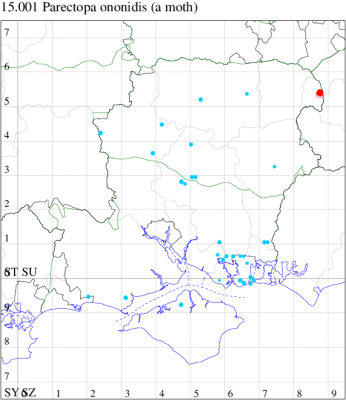
Records by year
Records by week (adult)
Records by week (larval)
Record Details
VC12: Cholderton, one, 31 Jul (TJN, HE); Farnborough*, one, 21 May (KBW)
15.002 [B&F: 0280] Caloptilia cuculipennella (Hübner, 1796) - Nationally Scarce A
Scarce in Britain as far north as Perthshire and in Ireland, especially on sea-cliffs and rough ground near the sea and woodland inland. Very rare in our area: Ffennell reported one from the Southampton area in 1935, and there are three old records from the Isle of Wight. Recent years have seen a scattering of further examples, with the first for North Hampshire coming in 2020. Wingspan 11-12 mm. Similar to C. syringella. Larva mines leaves of Ash and Wild Privet, subsequently living within a leaf-fold.
Records prior to 2020
| Vice County | #Records | #Individuals | First Record | Last Record |
|---|---|---|---|---|
| 10 | 5 | 13 | 1900 | 2015 |
| 11 | 3 | 2 | 1935 | 2014 |
2020 records
| Vice County | #Records | #Individuals | Max Quantity |
|---|---|---|---|
| 12 | 1 | 1 | 1 |
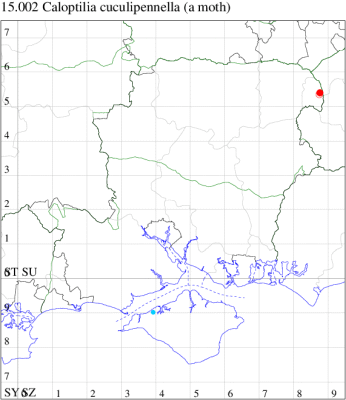
Records by year
Records by week (adult)
Records by week (larval)
Record Details
VC12: New Vice-county Record: Farnborough*, one, 25 Jun (KBW det. MJW)
15.003 [B&F: 0281] Caloptilia populetorum (Zeller, 1839) - Local
Local on moorland and heathland, and in open woodland. Widespread, with a discontinuous distribution which may be due to under-recording; found in southern Britain from Kent to Glamorgan and Herefordshire, in Cumbria and in western and northern Scotland; rare in Ireland, being recorded only from Cos Wicklow, Clare and Galway. First recorded in Hampshire at Farnborough in 1995, despite its presence being mapped in vice-counties 10 and 11 in MBGBI Vol 2 (1985), and still rarely encountered. Not recorded from the Isle of Wight to date. Wingspan 11-14 mm. Similar to C. falconipennella, which lacks the dark spots on the costa and fold and has the terminal cilia concolorous with the wing and the cilial lines distinct (MBGBI Vol 2). Larva mines and folds leaves of Birch, subsequently living within a leaf-fold.
Records prior to 2020
| Vice County | #Records | #Individuals | First Record | Last Record |
|---|---|---|---|---|
| 10 | 1 | 1 | 2017 | 2017 |
| 11 | 69 | 67 | 2003 | 2019 |
| 12 | 20 | 19 | 1995 | 2018 |
2020 records
| Vice County | #Records | #Individuals | Max Quantity |
|---|---|---|---|
| 11 | 5 | 5 | 1 |
| 12 | 3 | 3 | 1 |
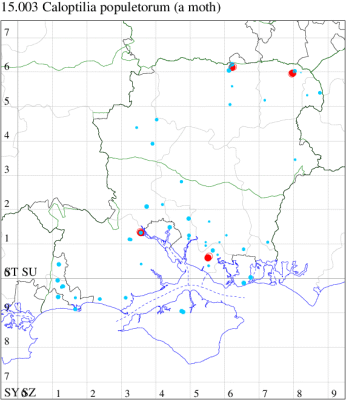
Records by year
Records by week (adult)
Records by week (larval)
Record Details
VC11: Totton, one, 17 Nov; one, 23 Nov (LH); Eastleigh, one, to actinic, 31 Jul (KArb); Catisfield, one, 10 Aug (ALR);
VC12: Pamber Forest, one, 05 Apr (GJD); Castle Bottom NNR, one, 25 Jun (JHH, AMD); one, to actinic, 16 Aug (JHH)
15.004 [B&F: 0282] Caloptilia elongella (Linnaeus, 1761) - Common
Common wherever the foodplant occurs, throughout much of the British Isles, as far north as the Orkneys. In Hampshire and on the Isle of Wight widespread and recorded from numerous localities throughout. Wingspan 14-16 mm. Overwinters as an adult, often in an evergreen such as Yew. The summer generation is relatively small and may not occur in unfavourable years. Similar to C. betulicola, C. rufipennella and C. hemidactylella. The larva feeds on Alder, at first mining the leaves and feeding initially on sap, later on the parenchyma; later it spins part of a leaf into a cone and lives and feeds therein.
Records prior to 2020
| Vice County | #Records | #Individuals | First Record | Last Record |
|---|---|---|---|---|
| 10 | 15 | 7 | 1900 | 2013 |
| 11 | 96 | 51 | 1973 | 2019 |
| 12 | 43 | 27 | 1981 | 2019 |
2020 records
| Vice County | #Records | #Individuals | Max Quantity |
|---|---|---|---|
| 11 | 3 | 2 | 1 |
| 12 | 2 | 1 | 1 |
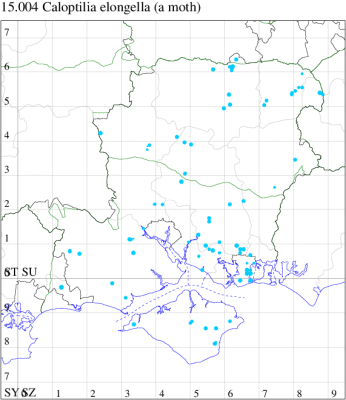
Records by year
Records by week (adult)
Records by week (larval)
Record Details
VC11: Eastleigh, one, to actinic, 11 Apr (KArb);
VC12: Cholderton, one, 31 Jul (TJN, HE)
15.005 [B&F: 0283] Caloptilia betulicola (Hering, 1928) - Common
Common wherever the foodplant occurs, throughout much of the British Isles. Widespread and common in Hampshire. Recorded for the first time on the Isle of Wight at Freshwater in 2010. Wingspan 14-16 mm. Separated with certainty from C. elongella only by dissection of the genitalia; similar to C. rufipennella and C. hemidactylella. Larva mines leaves of Birch, subsequently living within a leaf-cone.
Records prior to 2020
| Vice County | #Records | #Individuals | First Record | Last Record |
|---|---|---|---|---|
| 10 | 1 | 1 | 2010 | 2010 |
| 11 | 120 | 76 | 1973 | 2019 |
| 12 | 41 | 22 | 1975 | 2018 |
2020 records
| Vice County | #Records | #Individuals | Max Quantity |
|---|---|---|---|
| 11 | 2 | 4 | 3 |
| 12 | 2 | 2 | 1 |
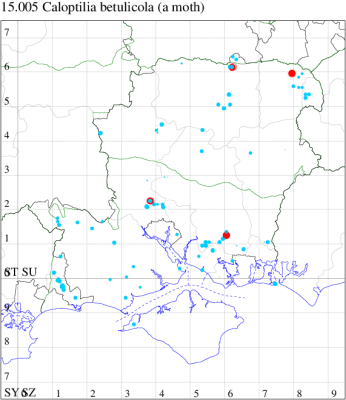
Records by year
Records by week (adult)
Records by week (larval)
Record Details
VC11: West Walk, larval spinning, three, on host-plant, spinnings on birch, 06 Jul (RJD);
VC12: Pamber Forest, one, 08 Jul (GJD); Castle Bottom NNR, one, netted, ♀, gen det, 15 Jun (JHH det. AMD)
15.006 [B&F: 0284] Caloptilia rufipennella (Hübner, 1796) - Common
Common in woodland, gardens, parks and fens throughout much of Britain, a recent colonist, reported for the first time only in 1970. By the time of MBGBI 2 (1986), the population was centred in Scotland and eastern England, and it has evidently continued to spread westwards since that time. First recorded in south Hampshire in 1990 and 1991, and has now been found throughout Hampshire and the Isle of Wight. Wingspan 11-12 mm. Similar to C. elongella and C. betulicola, which are larger (14-16 mm) and lack the pale band on the foretibia and the white admixture on the midfemur. Overwinters as an adult, often in an evergreen such as Yew. Larva mines leaves of Sycamore and occasionally other species of Acer, subsequently living within a leaf-fold, sometimes the most frequent Caloptilia species in gardens.
Records prior to 2020
| Vice County | #Records | #Individuals | First Record | Last Record |
|---|---|---|---|---|
| 10 | 54 | 60 | 1997 | 2019 |
| 11 | 521 | 573 | 1983 | 2019 |
| 12 | 111 | 85 | 1993 | 2019 |
2020 records
| Vice County | #Records | #Individuals | Max Quantity |
|---|---|---|---|
| 10 | 3 | 3 | 1 |
| 11 | 21 | 21 | 3 |
| 12 | 2 | 2 | 1 |
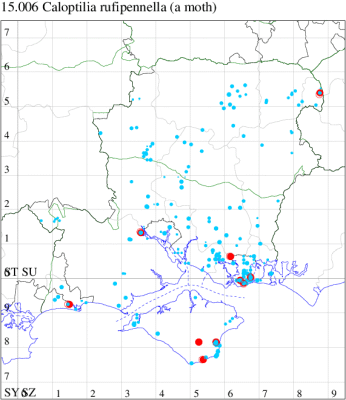
Records by year
Records by week (adult)
Records by week (larval)
Record Details
VC10: St Lawrence: Salem Close, one, to actinic, 01 Oct (PBa); Godshill, one, field observation, 19 Oct; Shanklin, one, gen det, 09 Apr (IOu);
VC11: Totton, one, 06 Aug (LH); Portsdown, larval feeding signs, one, on host-plant, at least one primary mine and two cones on sycamore, 14 Sep (RJD); Portsmouth, one, 23 Jul (IRT); Tuckton, Bournemouth, one, 12 Jul (APar); Southsea, one, 10 Apr; two, 07 Jul; one, 17 Jul (JGe); one, small specimen with multiple black spots on forewings, 20 Apr; one, 09 Nov; one, 13 Nov (JRL);
VC12: Harestock, one, to actinic, 12 Apr (GRog); Farnborough, one, 06 Aug (KBW)
15.007 [B&F: 0285] Azalea Leaf Miner Caloptilia azaleella (Brants, 1913) - Local
Local in parks, gardens and woodland throughout much of southern England, spreading into northern England. Thoroughly naturalised, through accidental introduction in azaleas and rhododendrons, this native of eastern Asia now occurs in the wild amongst Azalea species in several of the southern counties and more widely in greenhouses. In Hampshire early stages were first reported in a garden at Bournemouth, and subsequently from Southampton, Hilliers Arboretum and Ampfield. A few adult specimens have been taken at light elsewhere in southern Hampshire, but still rare in the north of the county and on the Isle of Wight, where first recorded at Totland in 2007. Wingspan 10-11 mm. Larva mines leaves of Azalea and Rhododendron, subsequently living within a leaf-fold, over-wintering as a pupa.
Records prior to 2020
| Vice County | #Records | #Individuals | First Record | Last Record |
|---|---|---|---|---|
| 10 | 10 | 9 | 2007 | 2019 |
| 11 | 1146 | 1454 | 1984 | 2019 |
| 12 | 33 | 29 | 1994 | 2019 |
2020 records
| Vice County | #Records | #Individuals | Max Quantity |
|---|---|---|---|
| 10 | 3 | 3 | 1 |
| 11 | 35 | 38 | 2 |
| 12 | 1 | 1 | 1 |
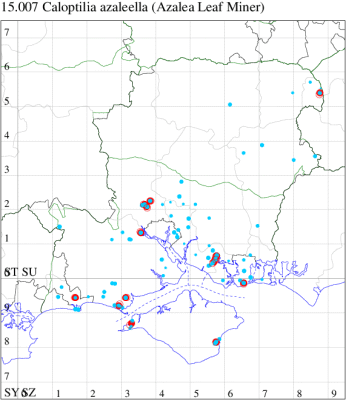
Records by year
Records by week (adult)
Records by week (larval)
Record Details
VC10: Totland, one, 20 Sep (RTe); Shanklin, one, 08 May; one, 06 Oct (IOu);
VC11: Totton, two, 03 May; one, 07 May; one, 02 Jul; one, 09 Jul; one, 10 Jul; one, 16 Jul; one, 17 Jul; one, 27 Jul; one, 28 Jul; one, 09 Sep; one, 20 Sep; one, 21 Nov (LH); Romsey, one, 26 May (SLay); two, 20 Sep (MB); one, 15 May; one, 19 May (NRJ); Southampton, one, 08 May; one, 16 May; one, 19 May; one, 21 May; one, 26 May; one, 30 May; one, 09 Aug; two, 12 Aug; one, 14 Aug (MEdg); Fareham, one, 03 May (ADT); one, 17 Jul (IMcP); one, to actinic, 02 Jul; one, to actinic, 02 Aug (MLO); Burton, nr Christchurch, one, 15 May; one, 23 Jul (JSw); Milford on Sea, one, 08 Jun (MMcM); Pennington, one, 17 Aug (RFC); Southsea, one, 27 May (JRL);
VC12: Farnborough, one, 09 May (KBW)
15.008 [B&F: 0286] Caloptilia alchimiella (Scopoli, 1763) - Common
Common in oak woodland and areas with scattered trees throughout much of the British Isles. In Hampshire and on the Isle of Wight reasonably well-distributed, but perhaps still under-recorded. Wingspan 10-13 mm. Easily confused with C. robustella, from which it can only safely be separated by dissection of the genitalia; both feed on oak, but C. alchimiella is probably univoltine with a protracted emergence period, while C. robustella is bivoltine. The adult rests by day on trunks, flies in the evening and comes sparingly to light; more frequently recorded in the larval stage, when mines are relatively easy to find where they are present. Larva mines leaves of Oak, subsequently living within a leaf-fold, over-wintering as a pupa.
Records prior to 2020
| Vice County | #Records | #Individuals | First Record | Last Record |
|---|---|---|---|---|
| 10 | 11 | 5 | 1900 | 2019 |
| 11 | 72 | 74 | 1971 | 2019 |
| 12 | 17 | 12 | 1975 | 2019 |
2020 records
| Vice County | #Records | #Individuals | Max Quantity |
|---|---|---|---|
| 10 | 1 | 1 | 1 |
| 11 | 2 | 2 | 1 |
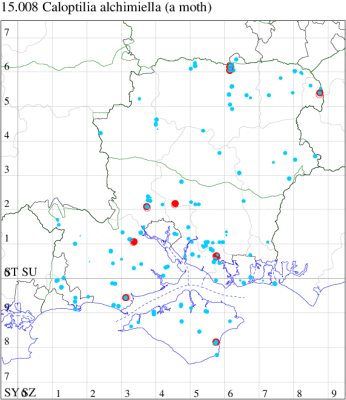
Records by year
Records by week (adult)
Records by week (larval)
Record Details
VC10: Shanklin, one, gen det, 23 Aug (IOu);
VC11: Ashurst, NF, one, 07 Aug; two, 08 Aug; three, 10 Aug; one, 14 Sep; one, 15 Sep (SAB); Romsey, one, 20 Sep (MB); Allbrook, one, 26 May (SI); Fareham, one, to actinic, gen det, 01 Aug (MLO det. RJD); Pennington, two, 29 May; one, 08 Aug (RFC);
VC12: Pamber Forest, one, 30 May; one, 06 Aug (GJD); Farnborough, one, 31 Jul; three, 08 Aug; one, 10 Aug (KBW)
15.009 [B&F: 0287] Caloptilia robustella Jäckh, 1972 - Common
Common in oak woodland and areas with scattered trees throughout Britain, as far north as Aberdeenshire; common in the south-east but rare in the west and north of its range; its apparent absence from much of the Midlands and central and southern Wales may be due to under-recording (MBGBI Vol 2). In Hampshire and on the Isle of Wight more common than C. alchimiella. Wingspan 10-13 mm. Easily confused with C. alchimiella, from which it can only safely be separated by dissection of the genitalia; both feed on oak, but C. alchimiella is probably univoltine with a protracted emergence period, while C. robustella is bivoltine. Larva mines leaves of Oak, subsequently living within a leaf-fold, over-wintering as a pupa.
Records prior to 2020
| Vice County | #Records | #Individuals | First Record | Last Record |
|---|---|---|---|---|
| 10 | 10 | 12 | 1980 | 2019 |
| 11 | 402 | 460 | 1972 | 2019 |
| 12 | 83 | 88 | 1975 | 2018 |
2020 records
| Vice County | #Records | #Individuals | Max Quantity |
|---|---|---|---|
| 10 | 3 | 5 | 3 |
| 11 | 17 | 17 | 2 |
| 12 | 3 | 3 | 1 |
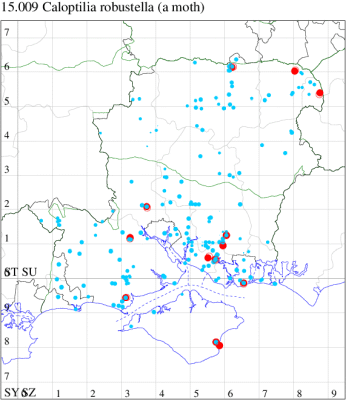
Records by year
Records by week (adult)
Records by week (larval)
Record Details
VC10: Shanklin, three, gen det, 21 May; one, gen det, 07 Aug; Shanklin Upper Chine, one, gen det, 02 Jun (IOu);
VC11: Woodlands, New Forest, present, 12 Aug (RBW); Romsey, one, 30 May; one, 06 Aug; one, 08 Aug; one, 11 Aug; one, 14 Aug; one, 16 Aug (MB); Catisfield, one, 12 Aug (ALR det. RJD); Fareham, one, 11 Aug (IMcP); Wickham, one, ♀, gen det, 07 Aug; West Walk, one, ♂, gen det, 14 Aug (F.M.G. det. RJD); Pennington, two, 24 Jun; one, 07 Aug; one, 08 Aug; one, 14 Aug (RFC); Southsea, one, 30 May (JRL);
VC12: Pamber Forest, one, 10 Aug (GJD); Farnborough, one, 26 May (KBW); Yateley*, one, ♂, gen det, 09 May (JHH det. AMD)
15.010 [B&F: 0288] Caloptilia stigmatella (Fabricius, 1781) - Common
Common in hedgerows, woodland and marshes, and on river-banks, throughout much of the British Isles. In Hampshire and on the Isle of Wight Mines and spinnings are common on sallows, willows and poplars in all three vice-counties. Wingspan 12-14 mm. Bivoltine, with a peak summer generation, the descendents of which overwinter. Imago seldom encountered at light, and more likely to be recorded in the larval stage, when mines are relatively easy to find where they are present. Larva mines leaves of Sallow, Willow, Aspen, Black Poplar and Grey Poplar, subsequently living within a leaf-fold.
Records prior to 2020
| Vice County | #Records | #Individuals | First Record | Last Record |
|---|---|---|---|---|
| 10 | 92 | 96 | 1900 | 2019 |
| 11 | 985 | 869 | 1971 | 2019 |
| 12 | 180 | 139 | 1980 | 2019 |
2020 records
| Vice County | #Records | #Individuals | Max Quantity |
|---|---|---|---|
| 10 | 3 | 3 | 1 |
| 11 | 29 | 24 | 2 |
| 12 | 7 | 7 | 1 |
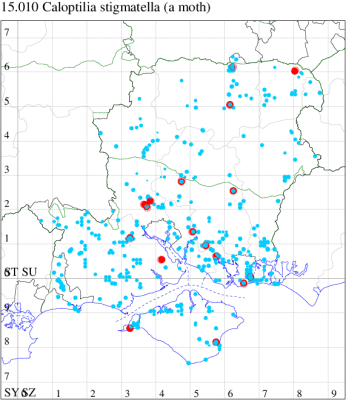
Records by year
Records by week (adult)
Records by week (larval)
Record Details
VC10: West High Down Quarry, one, 07 Aug; Shanklin, one, 09 Aug; one, 14 Aug (IOu);
VC11: Woodlands, New Forest, present, 31 May (RBW); Romsey, one, 10 Jun (SLay); one, 08 Aug; one, 07 Nov (MB); one, 18 Mar; one, 04 Aug (NRJ); Dibden Purlieu, one, to actinic, 09 Aug (RAC); Southampton, one, 22 Apr; one, 26 May (MEdg); Eastleigh, one, to actinic, 04 Aug (KArb); Winchester, one, 10 Apr (THW); Botley Wood, one, 13 Mar; one, 18 Sep (F.M.G.); Fareham, one, to actinic, 29 Jul (MLO); Botley, one, to actinic, 05 Aug (SLB); Wickham, one, 16 Jul (JRDS); Portsmouth, one, 07 Aug; one, 09 Nov (IRT); West Meon, one, 31 Jul (F.M.G.); Sway, one, 01 Apr (SKe); Pilley Bailey, NF, two, 03 Aug (RBW, MWa); Southsea, one, 26 May (JRL);
VC12: Anna Valley, Andover, one, 25 Jun (TJN); Basingstoke, one, 06 Aug (RHil); Pamber Forest, one, 25 May; one, 13 Jul; one, 28 Sep (GJD); Liss, one, 14 Aug (LBe); Yateley*, one, 12 Aug (JHH)
15.011 [B&F: 0289] Caloptilia falconipennella (Hübner, [1813]) - Nationally Scarce B
Nationally scarce (Nb) in marshes, river-banks, ditches and other damp areas throughout Britain, discontinuously north to Dunbartonshire. In Hampshire increased interest in recent years in micro-lepidoptera has uncovered a number of sites in the south-east and north-east of the county, so it is perhaps more widespread than previously known, or possibly increasing in range. Recorded for the first time on the Isle of Wight at Freshwater in 2011. Wingspan 12-14 mm. Larva mines leaves of Alder, make distinctive conical leaf-folds.
Records prior to 2020
| Vice County | #Records | #Individuals | First Record | Last Record |
|---|---|---|---|---|
| 10 | 4 | 6 | 2011 | 2016 |
| 11 | 79 | 60 | 1900 | 2019 |
| 12 | 23 | 5 | 2001 | 2018 |
2020 records
| Vice County | #Records | #Individuals | Max Quantity |
|---|---|---|---|
| 11 | 2 | 1 | 1 |
| 12 | 3 | 3 | 1 |
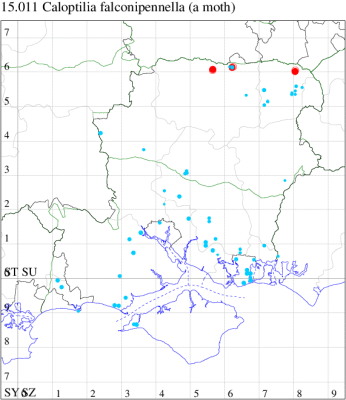
Records by year
Records by week (adult)
Records by week (larval)
Record Details
VC12: Axmansford*, one, 17 Nov (ACB det. GJD); Pamber Forest, one, 07 Apr (GJD); Yateley*, one, 31 Jul (JHH)
15.012 [B&F: 0290] Caloptilia semifascia (Haworth, 1828) - pRDB1
Local in woodland edges and hedgerows in southern England and Wales, widespread, but tending to occur in isolated but sometimes populous colonies; absent from the north Midlands, but reappearing in Yorkshire and Cumbria. Widespread and fairly common in Hampshire and on the Isle of Wight. Wingspan 10-12 mm. Since the synonymisation of C. hauderi into the present species, it is apparent that the adult is bivoltine, with a small first generation in spring, followed by a main emergence from July through September, remaining active into October before overwintering into the next year (Nota Lep. (2011), J.R.Langmaid).
Imagos are taken at light, but even more so as larval mines in the leaves of Field Maple, subsequently living within a leaf-fold.
Records prior to 2020
| Vice County | #Records | #Individuals | First Record | Last Record |
|---|---|---|---|---|
| 10 | 108 | 81 | 1856 | 2019 |
| 11 | 446 | 788 | 1976 | 2019 |
| 12 | 133 | 100 | 1979 | 2019 |
2020 records
| Vice County | #Records | #Individuals | Max Quantity |
|---|---|---|---|
| 10 | 7 | 8 | 2 |
| 11 | 36 | 39 | 3 |
| 12 | 19 | 37 | 6 |
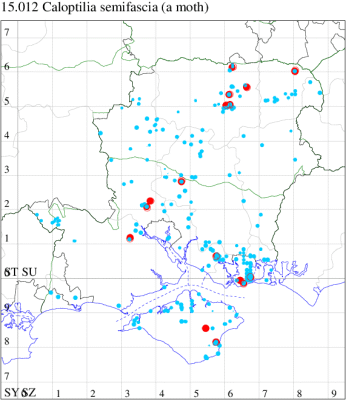
Records by year
Records by week (adult)
Records by week (larval)
Record Details
VC10: Haseley Manor, two, 06 Jul; one, 21 Sep; Shanklin, one, 02 Apr; one, 04 Apr; one, 25 Jun; one, 26 Aug; one, 17 Nov (IOu);
VC11: Woodlands, New Forest, present, 24 Mar (RBW); Romsey, one, 02 Apr (MB); one, 18 Mar; one, 05 Apr (NRJ); Southampton, one, 09 Aug (MEdg); Winchester, one, 23 Jun (THW); Fareham, one, to actinic, 24 Jun; one, to actinic, 01 Jul; one, to actinic, 28 Jul; one, to actinic, 30 Jul (MLO); Portsmouth, one, 17 Jun; one, 24 Jun; one, 25 Jun; one, 26 Jun; one, 30 Jun; three, 07 Jul; one, 08 Jul; one, 13 Jul; three, 15 Jul; two, 16 Jul; one, 17 Jul; one, 18 Jul; three, 22 Jul; one, 29 Jul; one, 07 Aug; one, 08 Sep; one, 12 Sep; two, 15 Sep; one, 22 Sep (IRT); Southsea, one, 26 Jun (JGe); one, 09 Apr (JRL);
VC12: Cholderton, two, 08 Aug (TJN, HE); Basingstoke, one, 10 Apr (DLev); three, 26 Jun; one, 31 Jul (MJW); four, 23 Jun; two, 24 Jun; one, 12 Jul; two, 31 Jul; one, 06 Aug (RHil); Chineham, mine, present, many larval cones on Field Maple, 11 Aug; Pamber Forest, one, 23 Jun; one, 13 Jul; one, 31 Jul (GJD); Yateley, two, 12 Aug; one, 14 Sep; one, ♀, gen det, 26 May; six, 31 Jul; six, 08 Aug; one, 17 Aug (JHH)
15.014 [B&F: 0293] Gracillaria syringella (Fabricius, 1794) - Common
Common in gardens and woodland throughout the British Isles, as far north as Shetland. Widespread and common in Hampshire and on the Isle of Wight, where the distribution of records show continuous presence from April to September with only a small trough in June, indicating protracted emergence of the first generation. Wingspan 10-13 mm. Imago seldom encountered at light, and more likely to be recorded in the larval stage, when mines are relatively easy to find where they are present. Imago similar to C. cuculipennella. Larva mines leaves of Privet (both wild and cultivated), Ash and Lilac, subsequently living gregariously within a leaf-roll, causing sufficient damage to be a serious pest in some areas, over-wintering as a pupa.
Records prior to 2020
| Vice County | #Records | #Individuals | First Record | Last Record |
|---|---|---|---|---|
| 10 | 322 | 422 | 1893 | 2019 |
| 11 | 1130 | 1753 | 1969 | 2019 |
| 12 | 291 | 254 | 1971 | 2019 |
2020 records
| Vice County | #Records | #Individuals | Max Quantity |
|---|---|---|---|
| 10 | 4 | 1 | 1 |
| 11 | 12 | 13 | 5 |
| 12 | 9 | 10 | 2 |
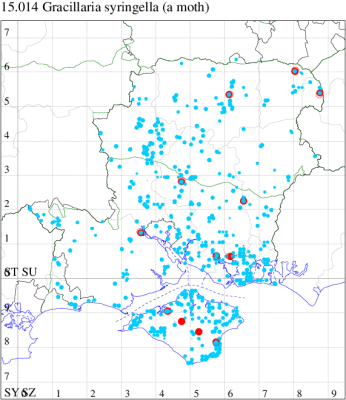
Records by year
Records by week (adult)
Records by week (larval)
Record Details
VC10: Plaish, mine, present, several on garden privet, 24 Sep (KRy); Walter's Copse, Newtown, mine, present, blotch mines on leaves of Fraxinus excelsior, 15 Sep (PBa); Merstone, mine, present, several on garden privet, 27 Sep (KRy); Shanklin, one, 24 Jun (IOu);
VC11: Totton, one, 08 Aug; one, 11 Aug; one, 15 Aug (LH); Romsey, one, 31 Mar (MB); Winchester, one, 10 Apr (THW); Fareham, one, to actinic, 19 Jun (MLO); Portsdown, larval feeding signs, five, on host-plant, old mines and spinnings on wild privet, 14 Sep (RJD); Hen Wood, one, 04 Sep (F.M.G.); Sway, one, 10 Apr (SKe);
VC12: Cholderton, one, 31 Jul (TJN, HE); Harestock, one, to actinic, 29 Apr; two, to actinic, 13 Jul; one, to actinic, 20 Oct (GRog); Ropley, one, 26 May (TJN, LF); Basingstoke, one, 12 Apr (MJW); Farnborough, one, field observation, 17 Apr (KBW); Yateley, one, 21 Apr; one, 21 May (JHH)
15.015 [B&F: 0294] Aspilapteryx tringipennella (Zeller, 1839) - Common
Common on downland, rough grassland, waste ground and roadside verges throughout the British Isles, as far north as Shetland. Common in Hampshire, scarcer on the Isle of Wight. Wingspan 10-13 mm. The imago is active in afternoon and evening sunshine and occasionally comes to light, and more likely to be recorded in the larval stage, when mines are relatively easy to find where they are present. Larva mines leaves of Ribwort Plantain, subsequently living within a leaf-roll.
Records prior to 2020
| Vice County | #Records | #Individuals | First Record | Last Record |
|---|---|---|---|---|
| 10 | 80 | 64 | 1850 | 2019 |
| 11 | 420 | 463 | 1971 | 2019 |
| 12 | 209 | 397 | 1980 | 2019 |
2020 records
| Vice County | #Records | #Individuals | Max Quantity |
|---|---|---|---|
| 10 | 4 | 9 | 4 |
| 11 | 18 | 19 | 2 |
| 12 | 11 | 12 | 2 |
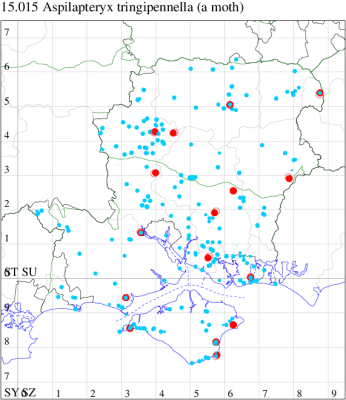
Records by year
Records by week (adult)
Records by week (larval)
Record Details
VC10: West High Down Quarry, three, 07 Aug (IOu); Bonchurch, one, 02 Jun (JHa); Shanklin, one, 08 Jun; Bembridge Fort, four, 06 Aug (IOu);
VC11: Totton, one, 19 Jul; one, 31 Jul; one, 22 Aug (LH); Kings Somborne, two, to actinic, 15 Jul (GCE); Southampton, one, 19 May (MEdg); Catisfield, one, 07 Aug (ALR); Hilltop, The Hangers, one, 01 Aug (SI); Portsmouth, one, 21 May; one, 23 Jul; one, 31 Jul; one, 07 Aug (IRT); West Meon, one, 31 Jul (F.M.G.); Pennington, one, 24 Jun (RFC);
VC12: Cholderton, one, 24 Jul; two, 31 Jul (TJN, HE); Anna Valley, Andover, one, 20 Jul (TJN); Harewood Forest, one, to actinic, 23 Jul; Barton Stacey, one, to actinic, 11 Aug (GCE); Ropley, one, 26 May (TJN, LF); Basingstoke, one, 16 Jul; one, 29 Jul; one, 06 Aug (RHil); Liss Forest, one, 18 Jul (RJM); Farnborough, one, 17 Jul (KBW)
15.016 [B&F: 0297] Euspilapteryx auroguttella Stephens, 1835 - Common
Common in coppiced woodland and rough grassland, and on roadside verges, throughout much of Britain. In Hampshire locally common, except in the south-west of the county; on the Isle of Wight, it is distinctly uncommon. Wingspan 9-10 mm. Metallic grey forewing with orange or yellow markings and white tips to antennae make this one of the easiest Gracillariidae to identify (MBGBI Vol 2). Imago fairly regular at light, but more frequently recorded in the larval stage, when mines are relatively easy to find where they are present. Larva mines leaves of St John's-wort, subsequently living within a leaf-cone, and over-wintering as a pupa.
Records prior to 2020
| Vice County | #Records | #Individuals | First Record | Last Record |
|---|---|---|---|---|
| 10 | 2 | 0 | 1997 | 1997 |
| 11 | 115 | 83 | 1974 | 2019 |
| 12 | 53 | 37 | 1971 | 2018 |
2020 records
| Vice County | #Records | #Individuals | Max Quantity |
|---|---|---|---|
| 11 | 1 | 1 | 1 |
| 12 | 4 | 4 | 1 |
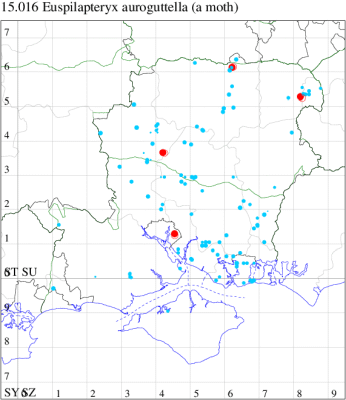
Records by year
Records by week (adult)
Records by week (larval)
Record Details
VC11: Bitterne*, one, to actinic, 27 Apr (PAB);
VC12: Cholderton, one, 08 Aug (TJN, HE); Chilbolton, one, to actinic, 15 Sep (GCE); Pamber Forest, one, 10 Aug (GJD); Fleet, one, 06 Aug (AGi)
15.017 [B&F: 0296] Calybites phasianipennella (Hübner, [1813]) - Local
Local in damp woodland, fens and cornfield edges throughout much of England, rare in Scotland and Ireland. In Hampshire and on the Isle of Wight recorded from all three vice-counties, but evidently rare and taken mostly as single specimens. Wingspan 10-11 mm. Imago fairly regular at light, but more frequently recorded in the larval stage, when mines are relatively easy to find where they are present. Larva mines leaves of Redshank, Black-bindweed, Common Sorrel, Sheep's Sorrel, Broad-leaved Dock, Water Dock and Yellow Loosestrife, subsequently living within a leaf-roll.
Records prior to 2020
| Vice County | #Records | #Individuals | First Record | Last Record |
|---|---|---|---|---|
| 10 | 17 | 15 | 1856 | 2018 |
| 11 | 137 | 151 | 1982 | 2019 |
| 12 | 38 | 44 | 1997 | 2019 |
2020 records
| Vice County | #Records | #Individuals | Max Quantity |
|---|---|---|---|
| 10 | 3 | 3 | 1 |
| 11 | 1 | 0 | 0 |
| 12 | 2 | 2 | 1 |
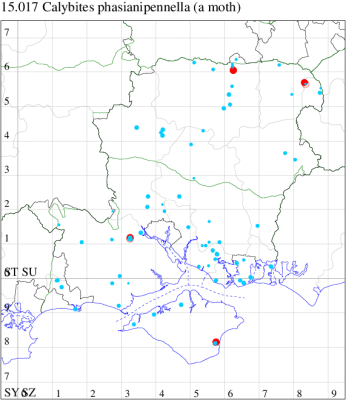
Records by year
Records by week (adult)
Records by week (larval)
Record Details
VC10: Shanklin, one, 14 Aug; one, 04 Sep; one, 08 Sep (IOu);
VC11: Woodlands, New Forest, present, 02 Aug (RBW);
VC12: Pamber Forest, one, 07 Sep (GJD); Foxlease Meadow, Rushmoor, one, field observation, 28 May (JHH)
15.018 [B&F: 0292] Povolnya leucapennella (Stephens, 1835) - Local
Nationally scarce (Nb) in oak woodland throughout much of Britain and Ireland. Rather uncommon in south Hampshire and very rare in the north and on the Isle of Wight. Wingspan 12-14 mm. Very variable, from pale yellowish white to reddish, and some forms are only separable from other similar Caloptilia species by dissection of the genitalia; however, the more common form is off white with darker spots, and this is distinctive. The mines on oak are very rarely reported; the few reports we have relate to adults taken at light or beaten from scrub.
Records prior to 2020
| Vice County | #Records | #Individuals | First Record | Last Record |
|---|---|---|---|---|
| 10 | 11 | 11 | 1900 | 2019 |
| 11 | 15 | 17 | 1973 | 2017 |
| 12 | 4 | 4 | 2006 | 2015 |
2020 records
| Vice County | #Records | #Individuals | Max Quantity |
|---|---|---|---|
| 10 | 5 | 6 | 2 |
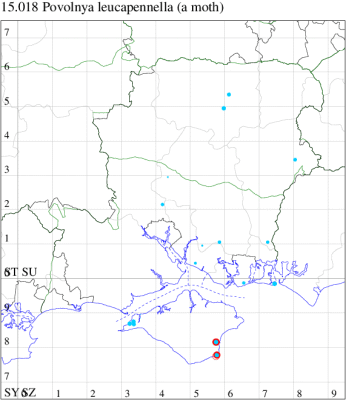
Records by year
Records by week (adult)
Records by week (larval)
Record Details
VC10: Bonchurch, one, 06 Apr; two, 10 Apr; one, 12 Jul; one, 13 Jul (JHa); Shanklin, one, 25 Jun (IOu)
15.019 [B&F: 0313] Acrocercops brongniardella (Fabricius, 1798) - Local
Local in open woodland, mainly south of a line from Lincolnshire to Herefordshire and Worcestershire, scarce elsewhere into Wales and Ireland (MBGBI Vol 2). Once rather scarce in Hampshire and on the Isle of Wight, this species has now been found widely throughout. Wingspan 8-10 mm. The second generation, when it occurs, overwinters to emerge in spring. Imago seldom encountered at light, and more likely to be recorded in the larval stage, when mines are relatively easy to find where they are present. Larva mines leaves of oak Quercus, including Evergreen Oak.
Records prior to 2020
| Vice County | #Records | #Individuals | First Record | Last Record |
|---|---|---|---|---|
| 10 | 109 | 51 | 1977 | 2019 |
| 11 | 148 | 64 | 1981 | 2018 |
| 12 | 23 | 14 | 1975 | 2019 |
2020 records
| Vice County | #Records | #Individuals | Max Quantity |
|---|---|---|---|
| 10 | 6 | 6 | 2 |
| 11 | 8 | 10 | 2 |
| 12 | 1 | 5 | 5 |
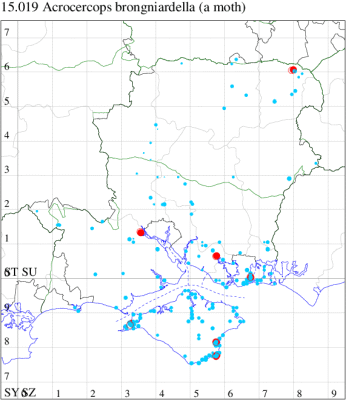
Records by year
Records by week (adult)
Records by week (larval)
Record Details
VC10: Totland, one, 20 Sep (RTe); Bonchurch, mine, present, leaf mines in Evergreen Oak, 02 Aug (IOu); two, 25 Jun (JHa); Shanklin, one, 09 May; one, 24 Jun; one, 25 Jun (IOu);
VC11: Totton, one, 30 Jun; one, 07 Jul (LH); Eastleigh, one, to actinic, 07 Aug (KArb); Fareham, one, to actinic, gen det, 09 Aug (MLO det. RJD); Portsmouth, one, 18 Jul; one, 21 Jul (IRT); Milton, vacated mine, two, Quercus ilex, 06 Feb; vacated mine, two, Quercus ilex, 06 Nov (JRL, IRT);
VC12: Yateley*, vacated mine, five, many on Holm Oak (Quercus ilex), 17 Dec (JHH)
15.022 [B&F: 0310] Callisto denticulella (Thunberg, 1794) - Common
Common in gardens, orchards, hedgerows and woodland in Britain, north to Perthshire, uncommon in Ireland. Widespread in Hampshire and on the Isle of Wight. Wingspan 10-12 mm. Imago fairly regular at light, but more frequently recorded in the larval stage, when mines are relatively easy to find where they are present. Larva mines leaves of Apple, subsequently living within a leaf-fold, over-wintering as a pupa in a cocoon.
Records prior to 2020
| Vice County | #Records | #Individuals | First Record | Last Record |
|---|---|---|---|---|
| 10 | 28 | 19 | 1973 | 2017 |
| 11 | 138 | 103 | 1975 | 2018 |
| 12 | 37 | 11 | 1984 | 2019 |
2020 records
| Vice County | #Records | #Individuals | Max Quantity |
|---|---|---|---|
| 10 | 1 | 2 | 2 |
| 11 | 1 | 2 | 2 |
| 12 | 1 | 1 | 1 |
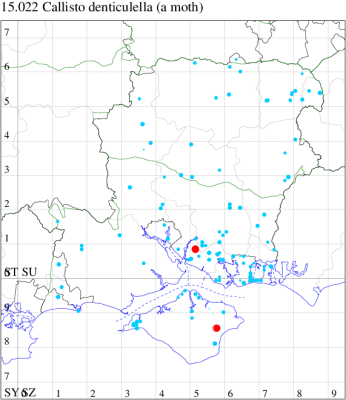
Records by year
Records by week (adult)
Records by week (larval)
Record Details
VC10: Alverstone, mine, two, on the upper surface leaves of Malus sp , a silvery mine, 17 Sep (PBa);
VC11: Swanwick, larval spinning, two, on host-plant, rolled leaf-margins on apple, 06 Dec (DWal);
VC12: Cheriton, one, field observation, 26 Apr (DAS)
15.025 [B&F: 0301] Parornix betulae (Stainton, 1854) - Common
Common on heathland and open woodland throughout much of the British Isles. Widespread and common in Hampshire, but rather less frequent on the Isle of Wight. Wingspan 9-10 mm. Very similar to P. loganella, from which separated only by dissection of the genitalia. Imago seldom encountered at light, and more likely to be recorded in the larval stage, when mines are relatively easy to find where they are present. Larva mines leaves of Birch, subsequently living within a leaf-fold, over-wintering as a pupa in a cocoon.
Records prior to 2020
| Vice County | #Records | #Individuals | First Record | Last Record |
|---|---|---|---|---|
| 10 | 12 | 20 | 1973 | 2017 |
| 11 | 258 | 175 | 1972 | 2019 |
| 12 | 64 | 37 | 1975 | 2019 |
2020 records
| Vice County | #Records | #Individuals | Max Quantity |
|---|---|---|---|
| 11 | 2 | 2 | 1 |
| 12 | 3 | 1 | 1 |
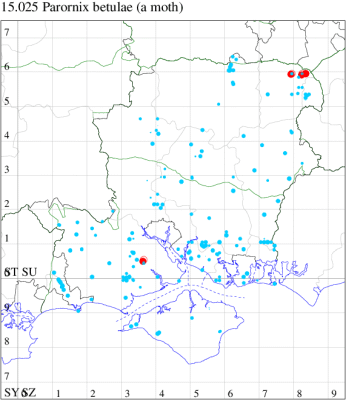
Records by year
Records by week (adult)
Records by week (larval)
Record Details
VC11: Pig Bush, NF, one, gen det, 17 Jul (CL);
VC12: Eversley, one, netted, ♂ gen det, 18 Jun; Yateley Common, mine, present, occupied mine on Birch (Betula pendula), 23 Nov; mine, present, on Birch (Betula), 15 Nov (JHH)
15.028 [B&F: 0303] Parornix anglicella (Stainton, 1850) - Common
Common in gardens, hedgerows and woodland throughout much of the British Isles to Perthshire, north of which it is more local and rare. In Hampshire and on the Isle of Wight common and widespread. Wingspan 9-11 mm. Similar to P devoniella, which has the ground colour paler and the dark markings more distinct and, on the underside, a distinct white line in the terminal cilia which is continued round the apex to unite with the costal strigula nearest the apex; in P. anglicella this line is more obscure and stops at the apex, not reaching the anteapical strigula (MBGBI Vol 2). Easily disturbed from its foodplants, around which it can be found flying from late afternoon, and it occasionally comes to light, but more frequently recorded in the larval stage, when mines are relatively easy to find where they are present. Larva mines leaves of Hawthorn and Wild Service-tree, subsequently living within a leaf-fold, over-wintering as a pupa in a cocoon.
Records prior to 2020
| Vice County | #Records | #Individuals | First Record | Last Record |
|---|---|---|---|---|
| 10 | 105 | 44 | 1900 | 2019 |
| 11 | 697 | 661 | 1972 | 2019 |
| 12 | 184 | 74 | 1971 | 2019 |
2020 records
| Vice County | #Records | #Individuals | Max Quantity |
|---|---|---|---|
| 10 | 2 | 1 | 1 |
| 11 | 13 | 54 | 20 |
| 12 | 3 | 1 | 1 |
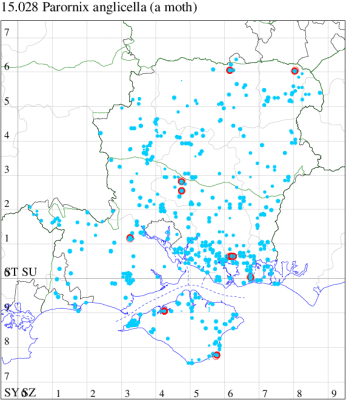
Records by year
Records by week (adult)
Records by week (larval)
Record Details
VC10: Newtown, mine, present, several on hawthorn, 26 Sep (KRy); Bonchurch, one, 02 Jun (JHa);
VC11: Woodlands, New Forest, present, 31 Jul (RBW); Twyford, larval feeding signs, nine, on host-plant, vacated cones on hawthorn, 10 Aug (RJD); Winchester, one, 02 Jun (THW); Portsdown, larval feeding signs, 20, on host-plant, a few primary mines and many cones on hawthorn, 14 Sep; larval feeding signs, 10, on host-plant, cones on hawthorn, 14 Sep; Portchester Common SSSI, larval feeding signs, 10, on host-plant, larval cones common on hawthorn, 14 Sep (RJD); Portsmouth, one, gen det, 07 May; one, 08 May; one, 16 May (IRT);
VC12: Pamber Forest, mine, present, on Hawthorn, 17 Oct (GJD); Yateley, one, ♂ gen det, 27 May (JHH det. AMD)
15.029 [B&F: 0304] Parornix devoniella (Stainton, 1850) - Common
Common in woodland and hedgerows throughout much of the British Isles, except in Scotland where it is rare. In Hampshire and on the Isle of Wight widespread and common. Wingspan 9-10 mm. Similar to P. anglicella, which see. Rests on trunks and flies in the evening around the foodplant, but more frequently recorded in the larval stage, when mines are relatively easy to find where they are present. Larva mines leaves of Hazel, subsequently living within a leaf-fold, over-wintering as a pupa in a cocoon.
Records prior to 2020
| Vice County | #Records | #Individuals | First Record | Last Record |
|---|---|---|---|---|
| 10 | 56 | 52 | 1977 | 2019 |
| 11 | 276 | 228 | 1972 | 2019 |
| 12 | 143 | 36 | 1975 | 2019 |
2020 records
| Vice County | #Records | #Individuals | Max Quantity |
|---|---|---|---|
| 10 | 6 | 6 | 3 |
| 11 | 4 | 14 | 10 |
| 12 | 6 | 2 | 1 |
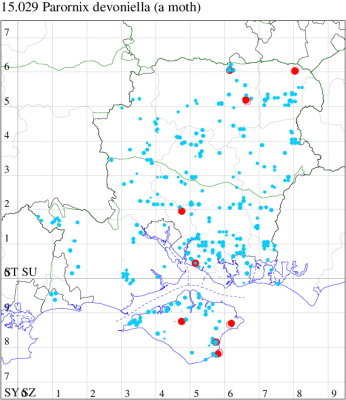
Records by year
Records by week (adult)
Records by week (larval)
Record Details
VC10: Plaish, mine, present, several on Hazel, 24 Sep (KRy); Bonchurch: Monk's Bay, mine, present, mines and leaf-folds on leaves of Corylus avellana, 30 Sep (PBa); Shanklin, one, gen det, 09 May; one, gen det, 19 May; one, gen det, 15 Jun (IOu); Brading*, mine, three, mines and leaf-folds on Corylus avellana, 19 Sep (PBa);
VC11: Bishopstoke, mine, 10, mines and leaf folds on hazel, 02 Nov (DHu); Chilling, mine, three, on hazel, 03 Dec; mine, present, plentiful on hazel, 04 Dec (DWal);
VC12: Crab Tree Plantation, larva, present, feeding signs, larvae in leaf fold, 06 Jun; Basingstoke, mine, present, leaf folded over at the tip; opened up to check if larva present, 06 Jun (MHak); Pamber Forest, mine, present, in leaf fold in hazel leaf, 24 Oct (GJD); Yateley*, one, ♂ gen det, 16 Jun; larva, present, field observation, on Hazel, 09 Nov (JHH)
15.030 [B&F: 0305] Parornix scoticella (Stainton, 1850) - Common
Common in gardens, orchards, woodland and moorland throughout much of the British Isles, more numerous in the north. In Hampshire there are scattered records from the mainland, but very rare on the Isle of Wight, where the only record dates from 1997. Wingspan 9-10 mm. Most similar to P. alpicola, but the white frons, usually immaculate white labial palpus and the less heavily marked forewing help to distinguish P. scoticella. Bivoltine in southern England. Imagos recorded at light require dissection for confirmed identification. More frequently recorded in the larval stage, when mines are relatively easy to find where they are present. Larva mines leaves of Rowan, Whitebeam and Apple, subsequently living within a leaf-fold, over-wintering as a pupa in a cocoon.
Records prior to 2020
| Vice County | #Records | #Individuals | First Record | Last Record |
|---|---|---|---|---|
| 10 | 1 | 0 | 1997 | 1997 |
| 11 | 52 | 31 | 1983 | 2019 |
| 12 | 29 | 19 | 1994 | 2019 |
2020 records
| Vice County | #Records | #Individuals | Max Quantity |
|---|---|---|---|
| 11 | 1 | 1 | 1 |
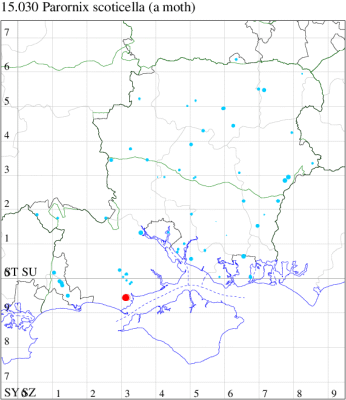
Records by year
Records by week (adult)
Records by week (larval)
Record Details
VC11: Pennington, one, 07 Aug (RFC)
15.032 [B&F: 0308] Parornix finitimella (Zeller, 1850) - Common
Common in scrub, woodland, hedgerows and gardens throughout much of southern England and Wales, with records north to Yorkshire. In Hampshire and on the Isle of Wight widespread, probably found wherever there is Blackthorn. Wingspan 9-10 mm. Vey similar to Deltaornix torquillella, which usually lacks the dark band on segment 3 of the labial palpus and which has the costal white strigula on the forewing continued round the apical dot and through the terminal cilia at an obtuse angle; often only safely separated by dissection of the genitalia. Imago seldom encountered at light, and more likely to be recorded in the larval stage, when mines are relatively easy to find where they are present. Larva mines leaves of Blackthorn, subsequently feeding in the fallen leaves, over-wintering as a pupa in a cocoon.
Records prior to 2020
| Vice County | #Records | #Individuals | First Record | Last Record |
|---|---|---|---|---|
| 10 | 10 | 11 | 1992 | 2019 |
| 11 | 67 | 54 | 1977 | 2019 |
| 12 | 34 | 23 | 1981 | 2015 |
2020 records
| Vice County | #Records | #Individuals | Max Quantity |
|---|---|---|---|
| 12 | 1 | 0 | 0 |
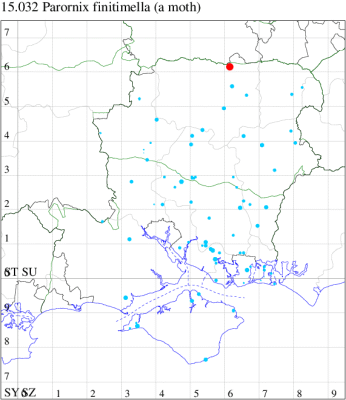
Records by year
Records by week (adult)
Records by week (larval)
Record Details
VC12: Pamber Forest*, vacated mine, present, on blackthorn, 18 Oct (GJD)
15.033 [B&F: 0309] Parornix torquillella (Zeller, 1850) - Common
Common in scrub, woodland, hedgerows and gardens throughout much of the British Isles. In Hampshire and on the Isle of Wight widespread. Wingspan 9-10 mm. Very similar to Parornix finitimella, which see for differences. Imago fairly regular at light, but more frequently recorded in the larval stage, when mines are relatively easy to find where they are present. Larva mines leaves of Blackthorn and Wild Plum, subsequently feeding in the fallen leaves, over-wintering as a pupa in a cocoon.
Records prior to 2020
| Vice County | #Records | #Individuals | First Record | Last Record |
|---|---|---|---|---|
| 10 | 36 | 33 | 1987 | 2019 |
| 11 | 154 | 147 | 1976 | 2019 |
| 12 | 37 | 27 | 1981 | 2018 |
2020 records
| Vice County | #Records | #Individuals | Max Quantity |
|---|---|---|---|
| 10 | 2 | 2 | 1 |
| 11 | 5 | 4 | 1 |
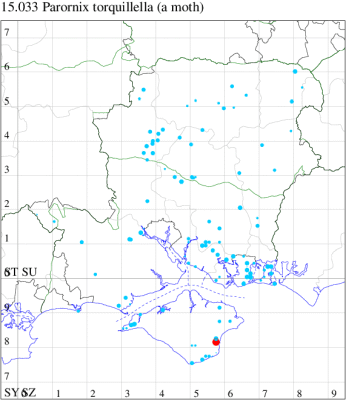
Records by year
Records by week (adult)
Records by week (larval)
Record Details
VC10: Shanklin, one, gen det, 02 Jun; one, gen det, 15 Jun (IOu);
VC11: Portsmouth, larva, one, field observation, Prunus spinosa, 23 Oct (JRL, IRT)

()(IMG_5307).jpg)